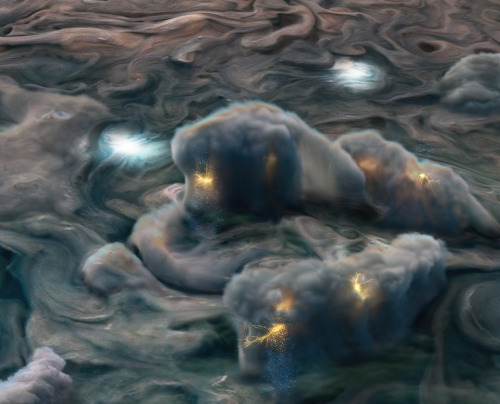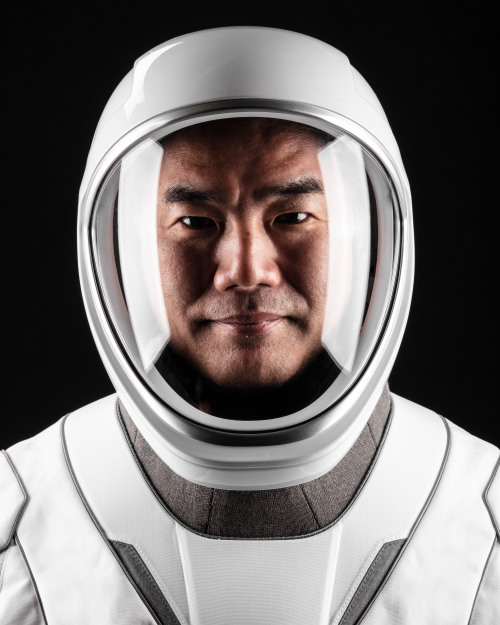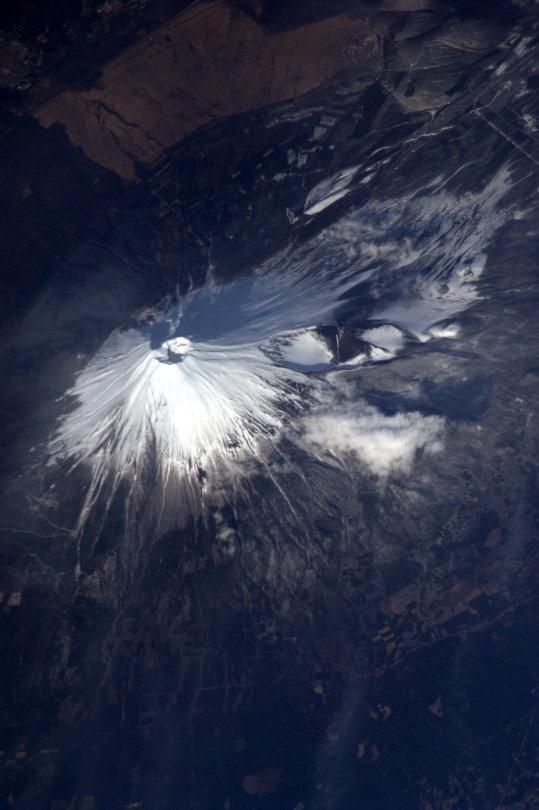Would Anybody Like Me To Do A Lesson On The Three Laws Of Thermodynamics???
Would anybody like me to do a lesson on the Three Laws of Thermodynamics???
More Posts from Science-child and Others

New results from our Juno mission suggest the planet is home to “shallow lightning.” An unexpected form of electrical discharge, shallow lightning comes from a unique ammonia-water solution.
It was previously thought that lightning on Jupiter was similar to Earth, forming only in thunderstorms where water exists in all its phases – ice, liquid, and gas. But flashes observed at altitudes too cold for pure liquid water to exist told a different story. This illustration uses data obtained by the mission to show what these high-altitude electrical storms look like.
Understanding the inner workings of Jupiter allows us to develop theories about atmospheres on other planets and exoplanets!
Illustration Credit: NASA/JPL-Caltech/SwRI/MSSS/Gerald Eichstädt/Heidi N. Becker/Koji Kuramura
Make sure to follow us on Tumblr for your regular dose of space: http://nasa.tumblr.com
Are You Up to the Task of Navigating Space with NASA?

We’re committed to exploration and discovery, journeying to the Moon, Mars, and beyond. But how do we guide our missions on their voyage among the stars? Navigation engineers lead the way!
Using complex mathematical formulas, navigation experts calculate where our spacecraft are and where they’re headed. No matter the destination, navigating the stars is a complicated challenge that faces all our missions. But, we think you’re up to the task!
Our space navigation workbook lets you explore the techniques and mathematical concepts used by navigation engineers. The book delves into groundbreaking navigation innovations like miniaturized atomic clocks, autonomous navigation technologies, using GPS signals at the Moon, and guiding missions through the solar system with X-ray emissions from pulsars — a type of neutron star. It also introduces you to experts working with NASA’s Space Communications and Navigation program at Goddard Space Flight Center in Greenbelt, Maryland.
If you’re a high schooler who dreams of guiding a rover across the rocky surface of Mars or planning the trajectory of an observer swinging around Venus en route to the Sun, this workbook is for you! Download it today and start your adventure with NASA: https://go.nasa.gov/3i7Pzqr
Who Was Mary W. Jackson?

On June 24, 2020, NASA announced the agency’s headquarters building in Washington, D.C., was to be named after Mary W. Jackson, the first African American female engineer at NASA.
Jackson’s story — along with those of her colleagues Katherine Johnson, Dorothy Vaughan, and Christine Darden — was popularized with the release of the “Hidden Figures” movie, based on Margot Lee Shetterly’s book by the same name.
Today, as the accomplishments of these women are brought to light, we celebrate them as Modern Figures — hidden no longer. Despite their recent recognition, we cannot forget the challenges that women and BIPOC faced and continue to face in the STEM fields.

Background
Jackson showed talent for math and science at an early age. She was born in 1921 in Hampton, Virginia, and attended the all-Black George P. Phenix Training School where she graduated with honors. She graduated from Hampton Institute (now Hampton University) in 1942 with a bachelor of science degree in both mathematics and physical sciences.
Jackson worked several jobs before arriving at the National Advisory Committee on Aeronautics (NACA), the precursor organization to NASA. She was a teacher, a receptionist, and a bookkeeper — in addition to becoming a mother — before accepting a position with the NACA Langley Aeronautical Laboratory’s segregated West Area Computers in 1951, where her supervisor was Dorothy Vaughan.

Accomplishments
After two years in West Computing, Jackson was offered a computing position to work in the 4-foot by 4-foot Supersonic Pressure Tunnel. She was also encouraged to enter a training program that would put her on track to become an engineer — however, she needed special permission from the City of Hampton to take classes in math and physics at then-segregated Hampton High School.
She completed the courses, earned the promotion, and in 1958 became NASA’s first African-American female engineer. That same year, she co-authored her first report, “Effects of Nose Angle and Mach Number on Transition on Cones at Supersonic Speeds.” By 1975, she had authored or co-authored 12 NACA and NASA technical publications — most focused on the behavior of the boundary layer of air around an airplane.

Legacy
Jackson eventually became frustrated with the lack of management opportunities for women in her field. In 1979, she left engineering to become NASA Langley’s Federal Women’s Program Manager to increase the hiring and promotion of NASA’s female mathematicians, engineers, and scientists.
Not only was she devoted to her career, Jackson was also committed to the advancement of her community. In the 1970s, she helped the students in the Hampton King Street Community Center build their own wind tunnel and run experiments. She and her husband Levi took in young professionals in need of guidance. She was also a Girl Scout troop leader for more than three decades.
Jackson retired from Langley in 1985. Never accepting the status quo, she dedicated her life to breaking barriers for minorities in her field. Her legacy reminds us that inclusion and diversity are needed to live up to NASA’s core values of teamwork and excellence.

Make sure to follow us on Tumblr for your regular dose of space: http://nasa.tumblr.com.
The Exploration Behind the Inspiration at NASA
Are we alone? How did we get here? Where are we headed?
At NASA, our mission is to explore. We visit destinations in our solar system and study worlds beyond to better understand these big questions.
We also dream. We dream of traveling to distant worlds, and what that might be like. In the video above you can see fanciful, imagined adventures to real places we’ve studied at NASA.
How We Did It
Check out how we created these otherworldly scenes in the video below. A NASA videographer used green screens to add motion and real people to bring life to our series of solar system and exoplanet travel posters.
Let’s dive into one example from the video. The shot of kayaking on Titan showcases the real rivers and lakes of liquid methane and ethane that slosh and flow on Saturn's largest moon. Titan's mysterious surface was revealed by our Cassini spacecraft, which also deployed the European Space Agency’s Huygens probe to the surface. The atmosphere on Titan is so thick, and the gravity so light, that with each strike of a paddle, you might be lofted above the swift current as you ride the tides through a narrow strait called the Throat of Kraken. NASA scientist Mike Malaska studies Titan and collaborated on the poster featured in the video. His research informed the artwork, and so did a hobby: kayaking. Those ultra-cold chemical seas might be even more of a challenge than shown here. Your boat might crack, or even dissolve, Malaska said.

We’ll learn more about Titan when our Dragonfly mission of dual quadcoptors — rotorcraft with eight blades each — visits the icy moon in 2034.
Science Never Stops
Our understanding of other worlds is always evolving, and sometimes we learn new details after we illustrate our science. In one of our travel posters, we show a traveler standing on the surface of exoplanet Kepler-16b with two shadows formed by the planet’s two suns. The planet does indeed orbit two stars, but with later size and mass refinements, we now think it would be hard to stand there and enjoy a binary sunset. There isn't a solid surface to stand on a gas planet, and that's what Kepler-16b now appears to be!
In addition to sharing how sublime science can be, these scenes are a reminder that there are lots of careers in the space program, not just scientist, engineer, or astronaut. A creative team at NASA’s Jet Propulsion Laboratory in Southern California produced the travel posters, originally to help share the work of NASA's Exoplanet Exploration Program. They are the result of lots of brainstorming and discussion with real NASA scientists, engineers, and expert communicators. The video versions of these spacey travel scenes were produced by visualization experts at NASA’s Goddard Space Flight Center in Greenbelt, Maryland.
All of this work is meant to inspire, and to explore the edge of possibility. It’s also an invitation. With science, we’re stepping into the future. Join us?

NASA Spotlight: Astronaut Soichi Noguchi
Soichi Noguchi was selected as an astronaut with the Japan Aerospace Exploration Agency in 1996. A native of Yokohama, Kanagawa, he is currently a mission specialist for NASA’s SpaceX Crew-1 launch taking flight to the International Space Station on Nov. 14. Soichi will be the first international crewmember on Crew Dragon and the first international partner astronaut to fly aboard three types of orbital spacecraft – the U.S. space shuttle, the Russian Soyuz, and now the SpaceX Crew Dragon! Talk about impressive. He received a B.S. in Aeronautical Engineering in 1989, master’s degree in Aeronautical Engineering in 1991, Doctor of Philosophy in Advanced Interdisciplinary Studies in 2020, all from the University of Tokyo.
Soichi took time from preparing for his historic mission to answer questions about his life and career:
You recently earned a doctorate in philosophy. What made you do it?
After my second flight, I started this research about your sensory system in zero gravity. I used a my own personal video, which I took during my last two flights at the International Space Station. I had a lot of interesting discussions amongst young professionals and students at the University of Tokyo about the research. It was a fun experience – but I would not do it again!
Space is a risky business. Why do it?
Space IS definitely a risky business. But the reward is higher than the risk so that’s why we take it.
Do you have a message for boys and girls in Japan who are interested in science and engineering?
Three words: Space. Is. Waiting.

Aside from mission objectives and tasks, what’s a personal goal for this mission?
We have a lot of interesting missions to do, but my personal goal is to return home with lots of fun stories.

What was it like to get the phone call to become an astronaut?
It was 25 years ago, but I still remember the voice vividly. I got a call from Dr. Mamoru Mohri, the very first JAXA astronaut, and he said “Welcome to the Astronaut Corps.” When I got the call to be part of the Crew-1 mission, I was a lot less nervous than when I was assigned to my first mission, but the excitement remains the same.
Can you describe your crew mate Mike Hopkins in one sentence?
He is a natural leader that takes care of the team really well, and he’s fun to play around with.

Star Trek or Star Wars?
Star Wars… just because!

Can you share your favorite photo or video that you took in space?
My favorite photo is Mount Fuji because I see the mountain almost every day when I was a child. It’s definitely breathtaking to see Mount Fuji from space.

What personal items did you decide to pack for launch and why?
I have lots of family photos, and I would put it inside my sleep station. Definitely one of the most challenging things about spaceflight is not experiencing zero gravity, not the rocket, but time away from family.
How would you describe spacewalking outside the space station?
It’s an excursion. The view of the Earth is just breathtaking because you are just one glass away from the vacuum of space. There’s nothing between you and Earth.

What are you most excited about for the future of human space exploration?
I would say I’m most excited for interplanetary travel to become more common so that the school kids can go to Mars on their field trip.
What would you say to someone looking to follow in your footsteps?
Don’t worry, be happy!
How has spaceflight evolved since your first launch and stay aboard the International Space Station in 2005?
This is definitely an exciting moment. We’re starting to see more players in the game. SpaceX is the frontrunner, but soon we’ll see Boeing, Sierra Nevada and Axiom. So the International Space Station will soon have more players involved, and it will be a lot more fun!
Thank you for your time, Soichi, and good luck on your historic mission! Get to know a bit more about Soichi and his NASA astronaut crew mates Victor Glover, Michael Hopkins, and Shannon Walker in the video above.
Watch LIVE launch coverage beginning at 3:30 p.m. EST on Nov. 14 HERE.
Make sure to follow us on Tumblr for your regular dose of space: http://nasa.tumblr.com
From now on, starting at the time you finish reading this message, your cells will no longer regenerate or multiply.
miNOsis
Bill Nye said wear a fucking mask!!!
Celebrating Spitzer, One of NASA’s Great Observatories
As the Spitzer Space Telescope’s 16-year mission ends, we’re celebrating the legacy of our infrared explorer. It was one of four Great Observatories – powerful telescopes also including Hubble, Chandra and Compton – designed to observe the cosmos in different parts of the electromagnetic spectrum.
Light our eyes can see
The part of the spectrum we can see is called, predictably, visible light. But that’s just a small segment of all the wavelengths of the spectrum. The Hubble Space Telescope observes primarily in the visible spectrum. Our Chandra X-ray Observatory is designed to detect (you guessed it) X-ray emissions from very hot regions of the universe, like exploded stars and matter around black holes. Our Compton Gamma Ray Observatory, retired in 2000, produced the first all-sky survey in gamma rays, the most energetic and penetrating form of light.

Then there’s infrared…
Infrared radiation, or infrared light, is another type of energy that we can’t see but can feel as heat. All objects in the universe emit some level of infrared radiation, whether they’re hot or cold. Spitzer used its infrared instrument to make discoveries in our solar system (including Saturn’s largest ring) all the way to the edge of the universe. From stars being born to planets beyond our solar system (like the seven Earth-size exoplanets around the star TRAPPIST-1), Spitzer’s science discoveries will continue to inspire the world for years to come.

Multiple wavelengths
Together, the work of the Great Observatories gave us a more complete view and understanding of our universe.

Hubble and Chandra will continue exploring our universe, and next year they’ll be joined by an even more powerful observatory … the James Webb Space Telescope!

Many of Spitzer’s breakthroughs will be studied more precisely with the Webb Space Telescope. Like Spitzer, Webb is specialized for infrared light. But with its giant gold-coated beryllium mirror and nine new technologies, Webb is about 1,000 times more powerful. The forthcoming telescope will be able to push Spitzer’s science findings to new frontiers, from identifying chemicals in exoplanet atmospheres to locating some of the first galaxies to form after the Big Bang.
We can’t wait for another explorer to join our space telescope superteam!
Make sure to follow us on Tumblr for your regular dose of space: http://nasa.tumblr.com


